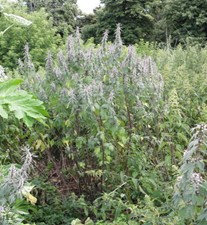Area
It grows in populated areas of Belarus, Ukraine, the European part of Russia (except the north), the Caucasus and western Siberia, in vacant and abandoned areas, in arable lands. The product is mainly produced in the Volga region, Bashkortostan and Voronezh region.
Botanical description of the plant
The five-part lion's tail - yasnotkadosh - belongs to the family Lamiaceae. A perennial herb, reaching a height of 50-150 (sometimes 200) cm. Stems multiple, quadrangular, erect, branched. The leaf is simple, clawed five-lobed, the upper three-lobed, opposite the base band. The flowers are 5-lobed, two-lobed, arranged in a ring in the axils of leaves at the top of the stem, forming a spike-shaped inflorescence. The fruit is triangular, dark brown, consisting of 4 nuts. It flowers from June to September and bears fruit. The leaves of the five-segmented lion-tail plant are stiff.

Medicinal properties
Medicinal drugs of the five-part lion's tail are used as a sedative (like valerian drugs) for the treatment of hypertension, nervous excitability and some heart diseases (cardiac neurosis, cardiosclerosis). Medicinal products. Tincture, tincture, liquid extract. The product is part of soothing teas
Growing technology
It can be grown on all irrigated (except saline) soils of Uzbekistan.
To grow a high yield from the lion's tail, we recommend planting it in well-watered soils. It is advisable to plant on fallow land after plowing.
Lion's tail is a perennial herbaceous plant with a woody rhizome, the root system is spread on the surface, ie in a 20 cm layer of soil, so it can be planted in autumn and early spring.
Before plowing the land in the fall, it is plowed to a depth of 20-25 cm, feeding 30 tons of manure and 50 kg of superphosphate fertilizer per hectare. The lion's tail is mainly propagated from seed. In late autumn, dry seeds are sown at 12-18 kg per hectare, and in early spring they are stratified at 7-8 kg and sown at a depth of 1.5-2 cm. After sowing the seeds on irrigated lands, irrigated plots are taken at intervals of 60–70 cm and watered successively. If the seeds are sown by mixing them with manure or sawdust, the spring rains will not cause frost and the seeds will germinate completely. 15-20 days after sowing, the grass starts to sprout. When caring for a lion’s tail in the first year, it is weeded by hand, the spacing is loosened, i.e. cultivated, and the plants are weighed to thin out the spacing.
Plant spacing is 15-20 cm and 1-2 plants are left in each nest. After flowering, the leaves are fed and irrigated with 50-60 kg of nitrogen and 20 kg of potassium fertilizers per hectare along with cultivation. The second and third feeding is fed with 30 kg of nitrogen, 20 kg of phosphorus and 30 kg of potassium fertilizer per hectare during the mowing and flowering phases. During this period, the plant's demand for fertilizer is highest, and the stems reach 2-2.5 meters. During the growing season, the lion's tail is watered 7-8 times and given a total of 110 kg of nitrogen, 80 kg of phosphorus and 60 kg of potassium fertilizer. Its raw material is a 40 cm long stem with leaves and flower stalks. In most plants, two-thirds of the flowers in the lower part of the inflorescence are in full bloom, while the period when the upper part of the inflorescence is in bloom is the full time of the raw material. When the seeds are fully ripe, the quality of the raw material deteriorates. It allows you to cut the stem of the raw material in the range of 35-80 cm, that is, you can cut the lion's tail at an average height of 50 cm. The raw material can be harvested in re-equipped combines. In the first year its yield is on average 25 quintals per hectare, in subsequent years it is possible to harvest 35 quintals. Seed yield averages 5-6 quintals per hectare. A lion's tail can be stored in a field for 3-4 years. Its raw material is dried in a shady place.





